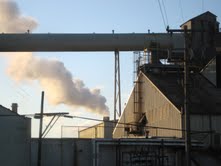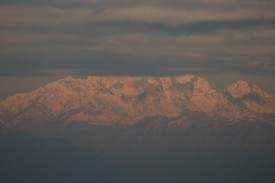Today I reported a story on some of the worst bad actors for air pollution in the Northwest. Interestingly, the facility with the most fines for air pollution violations in recent years wound up being a Seattle glass bottle maker that just a year ago was touting its eco bona fides. The folks at Verallia, which is owned by Paris-based Saint-Gobain, boasted about making $20 million in improvements to modernize its operations and save energy, and it crowed about its goal of increasing its use of recycled glass.
It’s great stuff for a manufacturer to do, but those improvements were the result of years of violations and lawsuits at the local and national level that forced the company to toe the green line. In the past five years, Verallia/Saint-Gobain was slapped with nearly $1 million in pollution penalties.
The article, which I wrote with Robert McClure for Investigate West, goes on to look deeper into Verallia/Saint-Gobain’s pollution problems, as well as other top recipients for air pollution penalties.
But there’s more to the story and it’s kind of interesting.
The article was part of a larger project that was done with the Center for Public Integrity’s iWatch News and National Public Radio. Reporters and researchers there made public record requests seeking to shine the light on the worst air polluters across the nation, enviro scofflaws that had flagrantly violated rules year after year.They turned up 383 facilities on the US Environmental Protection Agency’s “watch list.” The sites included “industrial, commercial, military, and municipal facilities such as oil refineries, steel mills, pharmaceutical manufacturers, incinerators, and cement kilns.”
Of that 383, only four made the list in Washington, Oregon, Idaho, and Montana. That included Verallia/Saint-Gobain; King County’s West Point sewage treatment plant; Jeld-Wen window and door maker in Oregon’s Klamath Falls; and an oil refinery called Montana Refining located in Great Falls, Mont.
This is a list of large facilities that have air pollution violations that have not been resolved in a timely manner (which the EPA sets at 270 days).
So why are there so few Northwest sites on the list, and does this mean the air is cleaner out here?
There’s no simple answer to those questions, though there are multiple interesting ones! First off, while we do have some notoriously problematic industries including oil refineries, this region isn’t steeped in coal plants and other massive polluters as other regions are. So our industrial and power providers naturally tip the region toward having fewer violators.
But I also wondered if the regulators here are just plain doing a better job tracking and enforcing the rules for polluters. In the past when I’ve written about water pollution in Washington, the state Department of Ecology often explained that they were too short staffed to update and enforce water permits in a timely fashion.
So I asked Laurie Halvorson, director of the Legal and Compliance Department of the Puget Sound Clean Air Agency, about their staffing levels. She said straight up that they have the staff to get the job done. The way her agency is set up, the permit fees the facilities pay cover the costs of regulating them.
The facilities “are highly regulated and we spend a lot of time to make sure that these issues are properly addressed and permitted,” Halvorson said.
Hmmm. So you adequately fund a program, and the public and environment get more timely oversight and protection. Love how that works!
But it didn’t make for super compelling journalism, so while we address the watch list, we shifted our focus for the story to the facilities that have had the largest amounts in penalties over the past five years (the list was developed by the news site EarthFix in collaboration with InvestigateWest and Northwest News Network based on information from the EPA’s very fun ECHO database).
That list was topped by Verallia/Saint-Gobain, and there were many others that racked up $100,000 or more in fines in recent years. And indeed, some of these facilities had problems that were taking months or even years to resolve, so it’s not like the Northwest is immune from industrial pollution lawbreakers, they just don’t seem to drag their heels as badly.
And besides, these businesses are able to LEGALLY release lead, dioxin, solvents, petroleum chemicals, and a whole laundry list of other potentially harmful pollutants each year. Verallia/Saint-Gobain alone legally spewed nearly 400 pounds of lead into the air last year, according to the EPA’s Toxic Release Inventory, a database I love.
So let’s get back to the second part of my question: Can the Northwest breathe easier than other parts of America?
Yes and no. While we appear, according to this national report, to have fewer recalcitrant environmental outlaws on the air pollution front, we have plenty of activities to foul our air. The challenging thing is, we don’t get to point to an industrial smokestack to lay the bulk of the blame. Most of our air pollution is coming from fireplaces and wood stoves, and our cars, trucks, planes, and ships. (Also note that this is true of our water quality problems — stormwater runoff from rooftops, roads, and driveways does more harm than industrial outfalls and sewage plants.)
“People are trying to take steps to understand who is contributing to local air toxics,” said Jeff KenKnight, unit manager for Compliance and Enforcement with the regional office of the EPA.
For example, the Tacoma and Pierce County areas are struggling to meet federal rules for itsy bitsy pollutants that get trapped in your lungs and cause serious damage, KenKnight said. What are the sources for that pollution, which is also known as fine particulate matter (PM2.5)?
Ten percent comes from industrial sources. The source for the rest is as follows: 53 percent woodsmoke, 20 percent gasoline, 5 percent diesel, 5 percent sea salt, 4 percent ships, 2 percent dust, 1 percent fireworks.
What’s the take home? In broad strokes, there are some air-pollution problem children in the Northwest, but they are getting hit with penalties. And the Northwest seems to be doing a better job of oversight and corrective actions, if you consider how many fewer facilities are on the EPA’s watch list. Finally, if residents really value clean air, it’s essential to keep working on reducing emissions from transportation and wood burning as those are the big pollution sources in many of our local communities.
Is all of this a breath of fresh air? Your call.











